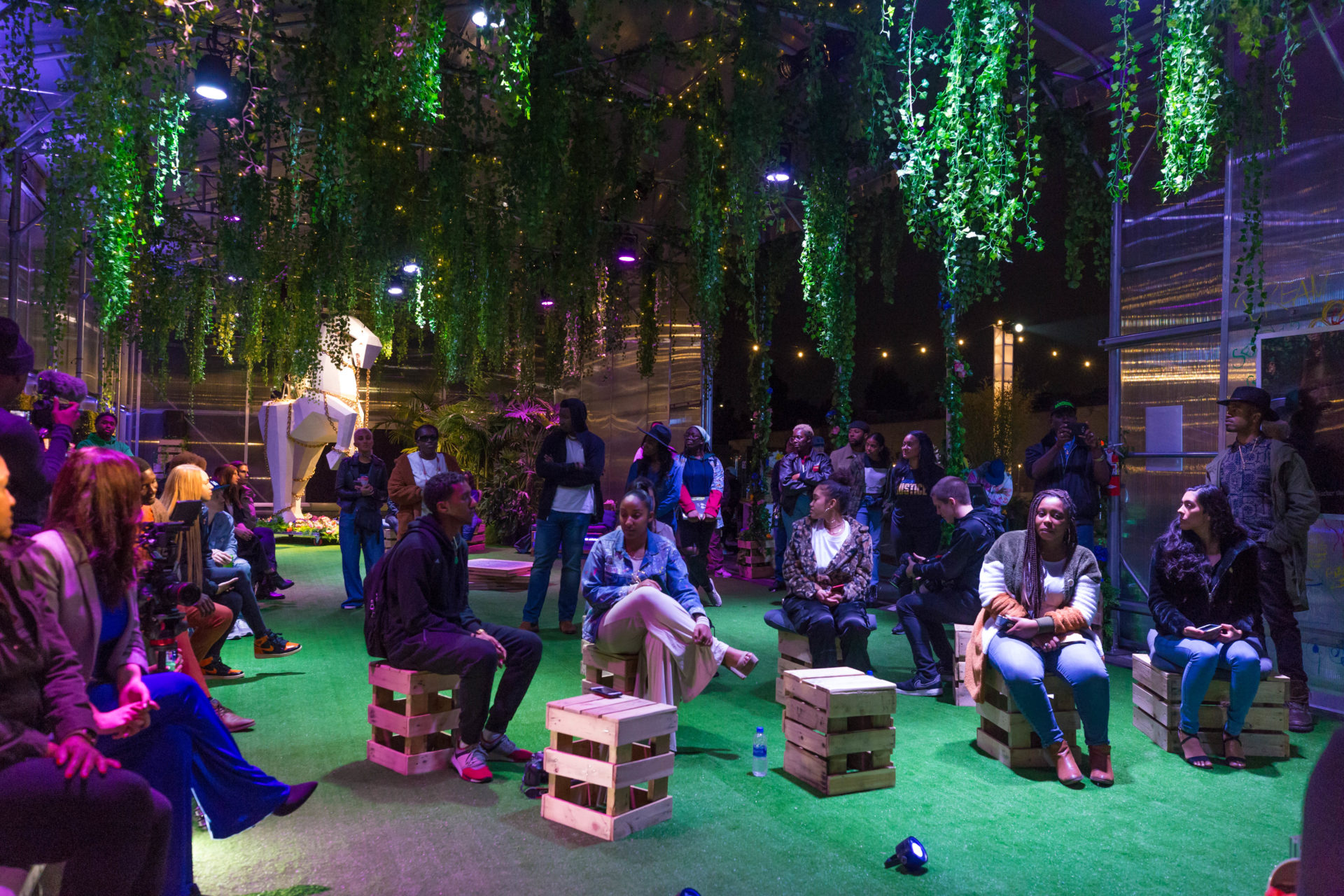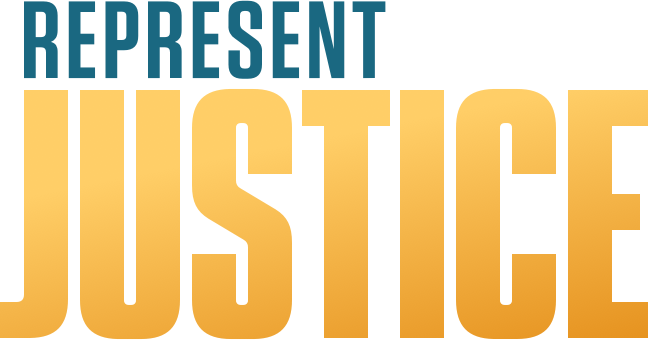PROXIMITY installation brought attendees closer to realities of incarceration

Proximity was a collaborative art installation between REPRESENT JUSTICE and Trap Heals, held Jan. 17-26 in South Central Los Angeles in conjunction with the nationwide release of the film JUST MERCY.
Through art and a slate of programming that centered system-impacted individuals, Proximity intended to increase public engagement around policy reforms, shift public opinion on incarcerated individuals and amplify the work of local criminal justice organizations.
To bring attendees proximate to incarceration and create a space for healing, the daily programming ran the gamut from artists and poets to athletes and faith leaders.
Jan. 19 was anchored around a Play for Justice panel discussion, where dancer Chloe Arnold, former NFL player and criminal justice advocate Brian Banks, and former Green Bay Packers running back Johnathan Franklin talked about the role of sports and art in activism and community work.
Two days later came a night of healing through music, with Los Angeles-based Las Cafeteras performing and Coldplay stopping by, fresh off of a benefit concert at the Hollywood Bowl for Reform Jails LA. And on Jan. 26, as the entire city of Los Angeles was mourning the death of Kobe Bryant and his daughter Gianna, inter-faith leaders gathered at Proximity after a screening of JUST MERCY to pray for those impacted by the loss and for incarcerated individuals and their loved ones.

“The judge pointed down at me and said I was irreparable.”Jarret Harper said, recalling the day he was sentenced to life without parole as a 17 year old. “That I would never walk amongst society again. That society wasn’t safe with me in it. So he cast me away, and told me that my last day should be spent inside of a cage.”
Harper, an advocate for criminal justice reform and foster care youth, stood in a greenhouse in a Baldwin Hills parking lot as part of PROXIMITY, an art installation in collaboration between Trap Heals and Represent Justice.
The installation, which ran from Jan. 17 through 26, was part of a larger campaign to shift public opinion on incarcerated individuals by allowing attendees to bear witness to their full stories. With nightly programming that included local artists, conversations between athletes and local spiritual leaders, and practitioners of reiki, acupuncture and massage, the space was created to allow attendees to heal through dialogue, art and to narrow the distance around incarceration.
The location, in South Los Angeles and across the street from the Cinemark Baldwin Hills where Just Mercy is screening, was intentional to acknowledge the neighborhood’s history as a cultural center for Black people in LA and the way mass incarceration has impacted the community.
With a lyrical dancer interpreting his story, Harper shared his experience of how multiple forms of abuse in the foster care system led to his incarceration until Gov. Gavin Newsom commuted his sentence on June 18, 2019.

“Where I come from, survival is the top priority,” Damon Turner of cultural architecture firm Trap Heals told the crowd on Thursday. “Self care is nowhere to be found.” Damon said creating a space where black people could heal around art, share community and invest in each other was the impetus for starting his organization Trap Heals, and for Proximity.
The lush greenhouse was equal parts event space and gallery, with art pieces that in one way or another brought attendees closer to the realities of people who are currently incarcerated.
Four portraits in ornate gold frames stood along one wall, each flanked by a phonebooth, created by Leimert Park Phone Co. By picking up the phone and pressing a button on the pad, attendees had the chance to hear the stories of the people in the portraits as well as messages from their friends and families, offering people the context they are so often denied.
Ms. Kelli was only 21 when she was sentenced to life without parole, she recalls through the grainy receiver. Born and raised in Los Angeles, Ms. Kelli was heavily bullied as a teenager and struggled to fit in.
“In Los Angeles in 1988, it was super dangerous to be LGBTQ,” she said. “Me being trans, I just remember the fear that was connected to being beat up. Suicide appeared to be my only option. Or drugs. Or prostitution.”

When she finally found a man who she trusted, and who she felt accepted her, she didn’t realize she’d wind up being implicated in a shootout and convicted of kidnapping and attempted murder. At her trial, Ms. Kelli recalled, the judge said she would have lowered the sentence if she had any discretion. Today, Ms. Kelli is an advocate for LGBTQ rights and is studying to become a counselor.
Next to Ms. Kelli’s portrait stood that of Jessie, who has been incarcerated at California State Prison, Corcoran since he was 22. He’s 17 years into a 227 year sentence.
Jessie had been impacted by the system nearly his whole life, he recalls through the recording.
“I remember the front door exploding, a bunch of officers rushing in our house.” he said. “They took my dad away.” Jessie was only five, and that was just the beginning of a series of traumatic events like violence, abuse, drug use, he admits he did not have the tools to cope with.
On Jan. 25, the space grew more intimate to make space for a poetry reading. The DJ moved inside as children danced with their parents in the center of the greenhouse.
Poet and artist Halim Flowers was the first to read that evening. Flowers, an ambassador for Represent Justice, recited poems about his experience with incarceration and his hope for a more just system.
“Superpredators became our labels/ that we were children became a fable,” a line from one poem read.
Halim, like other poets who read that night, was incarcerated as a teenager. At 16, he was sentenced as an adult to two life sentences. He was released on March 21, 2019, after serving 22 years. Since then, he’s continued to write and advocate for the implementation of restorative justice in the juvenile justice system.

The poets who read that evening used their art to diminish the stigma around incarceration, as many of them met as incarcerated youth who formed the Trapped Artists collective. For some collective members, it was their first time sharing their poetry with an audience. Another member, 88, delivered an especially moving set through the phone, as he is currently still incarcerated.
Hearing the testimonies of people who are incarcerated through the phone booths, and those who participated in PROXIMITY’s programming, it was clear there were more to their stories than their sentences could ever tell. Many had been failed by the very people and systems that were meant to protect them and experienced significant trauma by way of violence, drug use, neglect and abuse that they were not equipped to cope with.
“We’ve all done something.” Harper said to a crowd rising to their feet on Thursday evening. “You are not the same person, People in prison are not the same once they’ve been rehabilitated. But, we need to get serious about how we talk about rehabilitation.”
Check out the video recap below.
